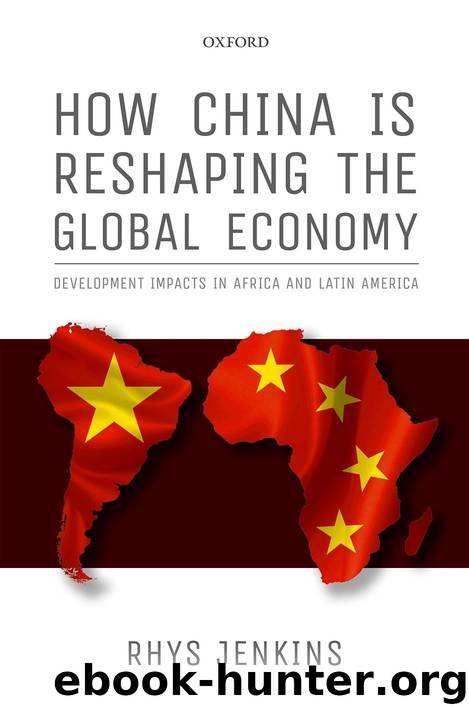How China Is Reshaping the Global Economy by Jenkins Rhys;

Author:Jenkins, Rhys;
Language: eng
Format: epub
Publisher: Oxford University Press USA - OSO
Published: 2018-11-01T16:00:00+00:00
8.4.1 Trade and Environment
As seen in Chapter 6, virtually all of SSA’s exports to China are primary products and resource-based manufactures, particularly oil, ores, and metals, which tend to have substantial environmental impacts. The growing Chinese market and increased prices of many primary commodities, as documented in Chapter 3, has created incentives for increased production of oil, minerals, and timber, which may have damaging environmental impacts.32 Oil exploration, production, and transport can give rise to major spillages with devastating environmental effects, as seen in the Niger Delta. Mining can lead to direct environmental destruction through vast opencast mines, pollution as a result of the toxic chemicals used in ore extraction, and the creation of vast quantities of waste. Water supplies may also be affected by mines’ demand for water. Logging, much of which is illegal, is often unsustainable and leads to widespread deforestation (WWF-UK, 2009, EV 109).
In the case of exports to China, there are numerous reports of environmental destruction in SSA, but what evidence is there that exports to China are more environmentally damaging than exports to other markets? Such an outcome could arise either because Chinese consumers are less aware or less concerned about the environmental impacts of their consumption than those in the West or because there is less government regulation of environmentally damaging imports in China or because there is a significant volume of illegal trade between SSA and China.
Because the bulk of SSA’s exports to China and elsewhere are made up mainly of undifferentiated commodities such as oil and copper, which are not sold to the final consumer, it is unlikely that exporters will have any incentive to differentiate between a product sold to China and one sold to other, more developed countries. Consumers can only take account of the environmental impacts of a product that they buy when there is some form of certification in place (see Section 8.4.3 on timber).
The ability of governments to take action against imports of goods produced in an environmentally damaging way is limited by World Trade Organization (WTO) rules that prevent discrimination on the grounds of how a product has been produced.33 Governments are, therefore, only able to restrict imports of environmentally damaging products under certain exceptional circumstances. Thus, neither consumer demand nor import regulations are likely to lead to a significant difference in the environmental impacts of goods exported to China compared to other markets.
In fact the most likely cause of exports to China having a negative environmental impact is where there is extensive illegal trade. In recent years conservationists have pointed to demand from China for ivory and rhino horn as a major threat to the African elephant and rhinoceros (Gao and Clark, 2014).34 Although important from the point of view of conservation, from the environmental point of view, the illegal trade in ivory and rhino horn is less significant than the illegal trade in timber. The impact of Chinese trade and investment in forestry is discussed in more detail in Section 8.4.3.
Download
This site does not store any files on its server. We only index and link to content provided by other sites. Please contact the content providers to delete copyright contents if any and email us, we'll remove relevant links or contents immediately.
| Arms Control | Diplomacy |
| Security | Trades & Tariffs |
| Treaties | African |
| Asian | Australian & Oceanian |
| Canadian | Caribbean & Latin American |
| European | Middle Eastern |
| Russian & Former Soviet Union |
The Secret History by Donna Tartt(18797)
The Social Justice Warrior Handbook by Lisa De Pasquale(12116)
Thirteen Reasons Why by Jay Asher(8762)
This Is How You Lose Her by Junot Diaz(6742)
Weapons of Math Destruction by Cathy O'Neil(6110)
Zero to One by Peter Thiel(5657)
Beartown by Fredrik Backman(5570)
The Myth of the Strong Leader by Archie Brown(5395)
The Fire Next Time by James Baldwin(5220)
How Democracies Die by Steven Levitsky & Daniel Ziblatt(5107)
Promise Me, Dad by Joe Biden(5065)
Stone's Rules by Roger Stone(5005)
A Higher Loyalty: Truth, Lies, and Leadership by James Comey(4819)
100 Deadly Skills by Clint Emerson(4818)
Rise and Kill First by Ronen Bergman(4676)
Secrecy World by Jake Bernstein(4614)
The David Icke Guide to the Global Conspiracy (and how to end it) by David Icke(4595)
The Farm by Tom Rob Smith(4415)
The Doomsday Machine by Daniel Ellsberg(4390)
